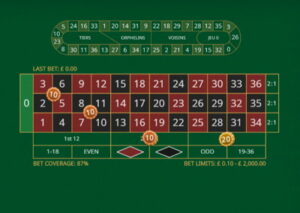 The Romanosky strategy is a roulette betting system in the category of the so-called large-coverage combined bets, that is, bets consisting of several placements of chips that cover as large as possible number of roulette numbers.
The Romanosky strategy is a roulette betting system in the category of the so-called large-coverage combined bets, that is, bets consisting of several placements of chips that cover as large as possible number of roulette numbers.
One of the elements of popularity of roulette is that players have the freedom to choose from a wide palette of combined bets. Each such bet has its own probability of winning, statistical and financial indicators (among which are the profit rate and the possible loss).
For players who want to play safely – with low probability of losing as the main criterion of their strategy – the large-coverage bets are the best option. However, the chips should not be spread chaotically on the roulette table.
One reason is that your bet may run into a contradictory bet – that is, a bet that always results in a financial loss, even when the winning number is in the bet’s coverage.
Another reason is that there is always a balance between each bet’s statistical indicators – a high probability of winning is counterbalanced by a low profit rate or a big potential loss – and you should choose those bets whose statistical indicators fit your personal strategy and goals.
The Romanosky strategy offers a large-coverage combined bet with a high probability of winning. In its classical form it consists of covering 32 numbers with 8 units of chips, while leaving 5 numbers out of the bets. This description applies for European (or French) roulette; however versions of this strategy may be devised for the American roulette as well.
Covering the 32 numbers may be done in various ways, by using certain simple bets such as Dozen bet, Column bet, Corner bet, and so on. Yet the number of choices for meeting that coverage is limited by the condition of using only 8 units (for instance, we cannot cover 32 numbers with Street bets and Split bets while using 8 units).
The several versions of the Romanosky strategy come from the choices we have for covering 32 numbers on the roulette table, but also from varying the number of units as the stake of each bet.
The Dozen-Corner Romanosky bet
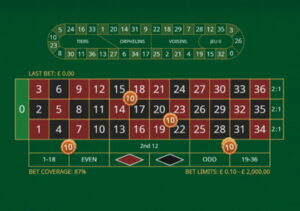 The most known and used version of the Romanosky strategy is a combined bet consisting on two Dozen bets with a stake of three units each and two non-overlapping Corner bets on numbers from the remaining dozen, with a stake of one unit each.
The most known and used version of the Romanosky strategy is a combined bet consisting on two Dozen bets with a stake of three units each and two non-overlapping Corner bets on numbers from the remaining dozen, with a stake of one unit each.
Of course, this category of bets breaks down into multiple choices, which are equivalent to each other with respect to their statistical indicators:
- 1st Dozen; 2nd Dozen; Square 27, 30, 26, 29; Square 33, 36, 32, 35 (numbers out of the bets: 0, 25, 28, 31, 34)
- 1st Dozen; 2nd Dozen; Square 33, 36, 32, 35; Square 26, 29, 25, 28 (numbers out of the bets: 0, 27, 30, 31, 34)
- 1st Dozen; 2nd Dozen; Square 27, 30, 26, 29; Square 32, 35, 31, 34 (numbers out of the bets: 0, 25, 28, 33, 36)
- 1st Dozen; 2nd Dozen; Square 26, 29, 25, 28; Square 32, 35, 31, 34 (numbers out of the bets: 0, 27, 30, 33, 36)
- 1st Dozen; 3rd Dozen; Square 15, 18, 14, 17; Square 21, 24, 20, 23 (numbers out of the bets: 0, 13, 16, 19, 22)
- 1st Dozen; 3rd Dozen; Square 21, 24, 20, 23; Square 14, 17, 13, 16 (numbers out of the bets: 0, 15, 18, 19, 22)
- 1st Dozen; 3rd Dozen; Square 15, 18, 14, 17; Square 20, 23, 19, 22 (numbers out of the bets: 0, 21, 24, 13, 16)
- 1st Dozen; 3rd Dozen; Square 14, 17, 13, 16; Square 20, 23, 19, 22 (numbers out of the bets: 0, 15, 18, 21, 24).
- 2nd Dozen; 3rd Dozen; Square 3, 6, 2, 5; Square 9, 12, 8, 11 (numbers out of the bets: 0, 1, 4, 7, 10).
- 2nd Dozen; 3rd Dozen; Square 9, 12, 8, 11; Square 2, 5, 1, 4 (numbers out of the bets: 0, 3, 6, 7, 10).
- 2nd Dozen; 3rd Dozen; Square 3, 6, 2, 5; Square 8, 11, 7, 10 (numbers out of the bets: 0, 9, 12, 1, 4).
- 2nd Dozen; 3rd Dozen; Square 2, 5, 1, 4; Square 8, 11, 7, 10 (numbers out of the bets: 0, 3, 6, 9, 12).
The probability of winning any of the bets 1) to 12) in European roulette is 32/37 = 86.48% and the probability of losing it is 5/37 = 13.51%. The expected value for this bet is EV = – 0.2162 u, where u is the value of the unit chip; in percentage of the initial stake, this is – 2.70%, which stands as the expected value of any roulette bet .
Playing this bet constantly, you are statistically expected to loose about 2.7 cents at every dollar bet over the long run. Despite the high probability of winning, expectation is not higher than for a usual simple bet.
This of course happens because of the high possible loss, namely 8 units, in case one of the five numbers out of bets occurs. The next table shows the statistical and financial indicators of this type of bet, where the financial percentages apply to the value of the total stake:
| Event | Winning any Dozen bet | Winning any cornet bet | Not winning any bet | |||
|---|---|---|---|---|---|---|
| EV | Probability | Profit rate | Probability | Profit rate | Probability | Loss rate |
| –2.70% | 64.86% | 12.50% | 21.62% | 12.50% | 13.51% | 100% |
Expected value (EV), profit and loss rates are calculated by employing the payout odds for the dozen bet (1 : 1) and cornet bet (8 : 1).
Of course, the figures in the table above apply for any of the twelve choices described previously.
We can see that winning the bet gives as overall profit the value of the total stake (eight unit chips in our definition, but it could be any stake) multiplied by 0.125 (that is, 1/8 of that stake or the stake on a corner bet), regardless of what bet (Dozen or Corner) is won. In the case all bets are lost, the loss is the stake of that combined bet.
In brief, you have about 86% chances of winning a Dozen-Corner Romanosky bet; if you win, the profit is just 1/8 of the total stake.
Other versions of the Romanosky bet
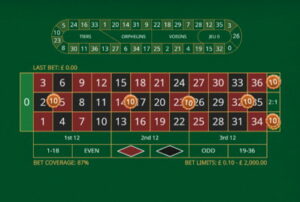 There are also other ways of covering 32 numbers with 8 chips, which results in versions of the Romanosky bet based on placements. Each version has its own statistical and financial indicators, which differ from those of the classical Romanosky bet.
There are also other ways of covering 32 numbers with 8 chips, which results in versions of the Romanosky bet based on placements. Each version has its own statistical and financial indicators, which differ from those of the classical Romanosky bet.
There is the Column-Split version, consisting of two Column bets with a stake of two units each and four non-overlapping Split bets on numbers of the remaining column with a stake of one unit each.
Without entering the statistics of this bet, observe that winning a Column bet results in a loss: 4u – 2u – 4u = – 2u; winning a Split bet results in a profit of 17u – 3u – 4u = 10u.
Although the probability of winning (having the winning number in the coverage) is the same as in the classical Romanosky bet (86%), this probability is not reflected entirely in the financial gain.
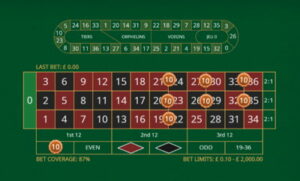 There is also the Low/High-Split version, consisting of a bet on Low (1-18) or High (19-36) numbers with the stake of one unit and seven non-overlapping Split bets on remaining numbers (High/Low) with the stake of one unit each.
There is also the Low/High-Split version, consisting of a bet on Low (1-18) or High (19-36) numbers with the stake of one unit and seven non-overlapping Split bets on remaining numbers (High/Low) with the stake of one unit each.
As in the Column-Split version, winning the Low/High bet results in a loss (– 6u). Winning a Split bet results in a profit of 10u.
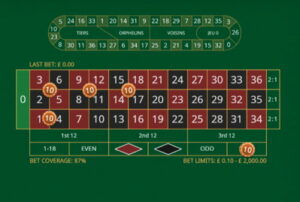 Still using a Low/High bet, we have a version completing this bet with three Corner bets and one Split bet (non-overlapping), on remaining numbers (High/Low), with the stake of one unit each, while the stake of the Low/High bet is four units.
Still using a Low/High bet, we have a version completing this bet with three Corner bets and one Split bet (non-overlapping), on remaining numbers (High/Low), with the stake of one unit each, while the stake of the Low/High bet is four units.
In this version, winning the Low/High bet results in zero profit (no loss), winning a Corner bet results in a profit of one unit (u), and winning the Split bet results in a profit of 10u. The statistical and financial indicators of this combined bet are given in the table below:
| Event | Winning the Low/High bet | Winning any Corner bet | Winning the Split bet | Not winning any bet | ||||
|---|---|---|---|---|---|---|---|---|
| EV | Probability | Profit rate | Probability | Profit rate | Probability | Profit rate | Probability | Loss rate |
| –2.70% | 48.64% | 0 | 32.43% | 12.50% | 5.40% | 125% | 13.51% | 100% |
The high profit rate when winning the Split bet should not be decisive in choosing this version. This event happens with only 5.40% probability and the most frequent situations are those in which the profit is zero (48.64%). These indicators are also reflected in the expected value of this bet, which remains –2.70% despite the variations.
Other versions of the Romanosky bet can be defined as well using the Line, Street, and even Straight-up bets; however no one of these have better indicators than the versions described above.
Conclusion
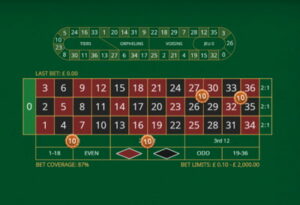 Although all the versions of the Romanosky bet have the same overall probability of winning associated (86%), the classical Dozen-Corner version has the best financial indicators. Regarding probability, this is not the highest probability of winning that roulette can provide for combined bets – it can reach 92% for certain large-coverage combined bets. However, it is not only the winning probability that counts when evaluating a bet, but also its financial indicators and the balance between the statistical and financial indicators.
Although all the versions of the Romanosky bet have the same overall probability of winning associated (86%), the classical Dozen-Corner version has the best financial indicators. Regarding probability, this is not the highest probability of winning that roulette can provide for combined bets – it can reach 92% for certain large-coverage combined bets. However, it is not only the winning probability that counts when evaluating a bet, but also its financial indicators and the balance between the statistical and financial indicators.
The high probability of winning and relatively low profit rate makes this strategy suitable for a safe play on short to medium run, especially when trying to restore damaged bankrolls.
They say that the (classical) Romanosky strategy is a kind of “mysterious” strategy, but the rationale behind conceiving it is visible from the mathematical description in this article – the bets are so combined to provide a profit (even low) in either situation of hitting a number in the bet’s coverage. In addition, the high probability of winning and the profit rates are well balanced compared to other large-coverage bets.
About The Author
The author of this page is Dr. Catalin Barboianu. Catalin is a mathematician specialising in gaming and responsible gambling and a research associate at the University of Bucharest.
